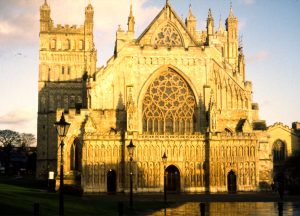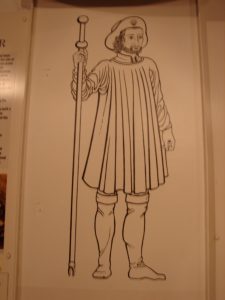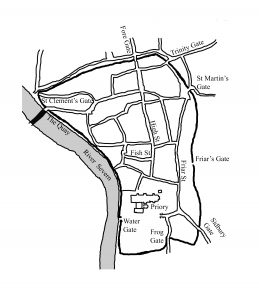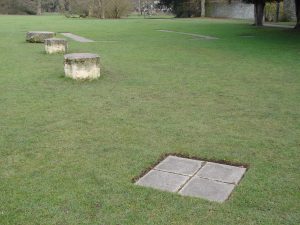The cathedral church of a diocese means the church which contains the seat or throne, a cathedra, of the bishop of the diocese. The Church of England has a mixture of what are called secular and monastic cathedrals. This division in terminology began with the Roman Catholic Church in England and was very much present at the time of the Lady Apollonia West Country Mysteries in the late 14th and early 15th centuries. After the break with Rome, the dissolution of the monasteries by King Henry VIII, and the beginning of the Church of England, a category of cathedrals of the new foundation was added. This blog post will talk about secular cathedrals while in later postings I will speak of monastic cathedrals and those of the new foundation.
As many of you know, I was a steward and tour guide in Exeter Cathedral during the four different years that we lived in England. This marvellous opportunity for me as an American gave me hands-on experience of a living church of the fourteenth century and became my inspiration for creating the Lady Apollonia stories. Exeter Cathedral is one of England’s medieval secular cathedrals and looks much as it did in 1380 when Plague of a Green Man, the 2nd of the Lady Apollonia West Country Mysteries, was set.
The phrase, secular cathedral, might sound like an oxymoron because the basic meaning of secular is non-religious. We must remember, however, that secular cathedral is the mother church of the diocese having the bishop’s throne but one in which the cathedral clerics are not bound by some monastic rule.
Exeter Cathedral, like other secular cathedrals in medieval times, was governed by a dean and a chapter of clerics called canons. The canons lived celibate lives as priests but they were not bound by the rules of a monastic order such as the Benedictines.
England has two archbishops, one in Canterbury and one in York. Interestingly, Canterbury Cathedral was a monastic church while York Minster was secular. The other famous secular cathedrals in England besides Exeter and York were Chichester, Hereford, Lichfield, Saint Paul’s London, Salisbury, Wells, and Winchester.
Exeter Cathedral, washed by a late afternoon rain, is pictured below.




